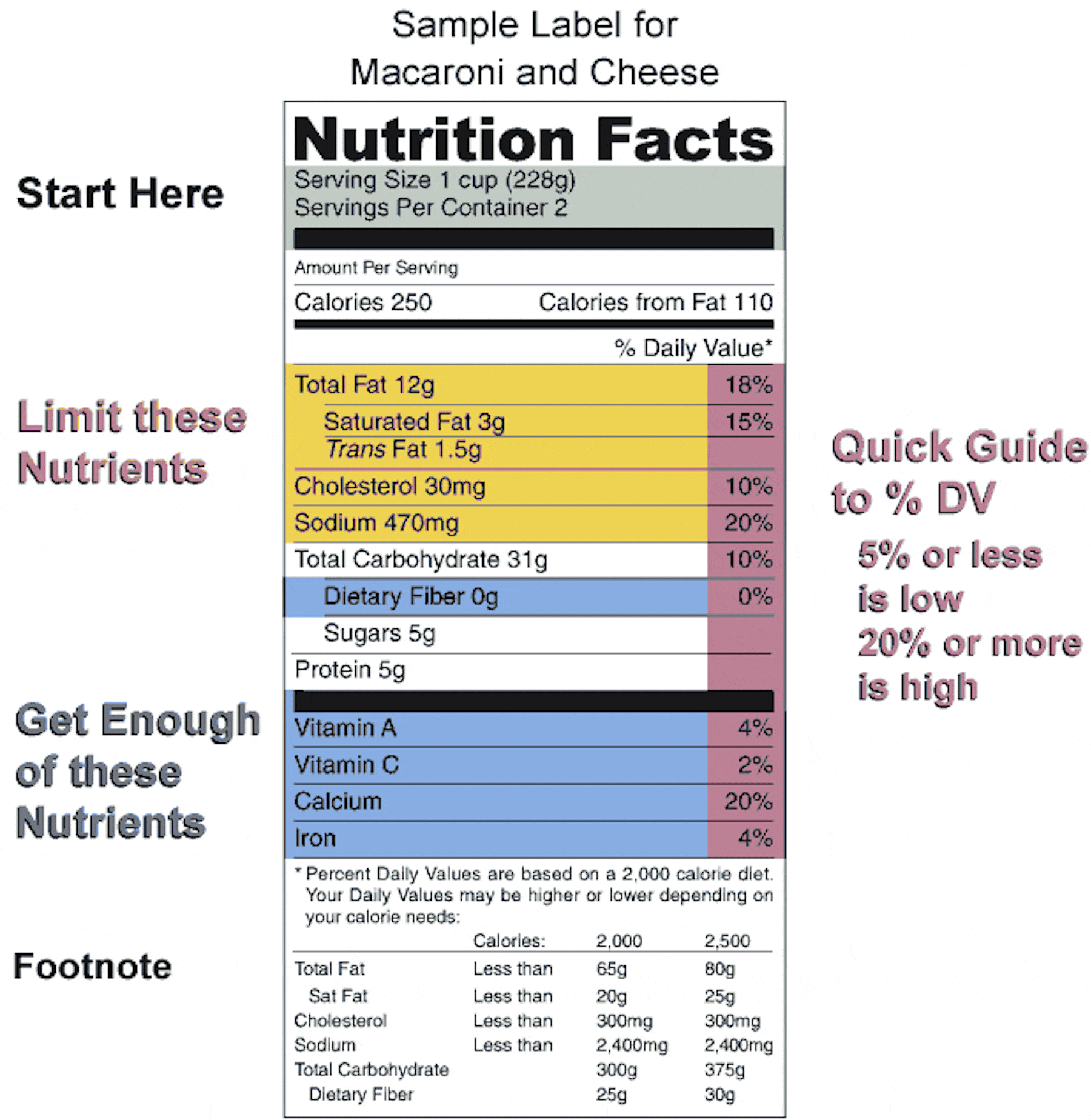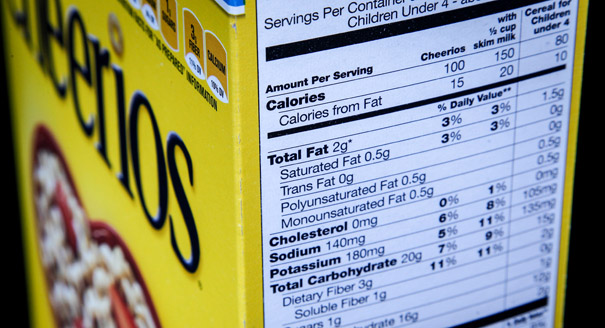45 calorie used on food labels is equal to
How Many Calories to Feed Your Dog Per Day - The Spruce Pets A calorie is a unit of energy. The term is used to describe energy content in food and the energy requirements of animals. One kilocalorie, or kcal, is equal to 1000 calories. However, the term "Calorie" is generally used to describe one kcal when looking at food labels or discussing dietary needs. How to Calculate Calories From Carbohydrates, Proteins and Fats The 4-9-4 rule is a simple way to calculate the number of calories you'll get from each macronutrient in a food. To use the 4-9-4 rule, check your nutrition label and follow these formulas: Find "Total Carbohydrates" and multiply the amount by 4. This will give you the number of calories in the food that comes from carbs.
How calories are calculated: Science behind the | Live Science A calorie is a unit of energy, not a measure of weight or nutrient density. The calories you see on nutrition labels, however, are actually kilocalories, or kcals, according to the National Health...
Calorie used on food labels is equal to
Do Menu Calorie Counts Actually Change How We Eat? A pound of fat may roughly equal 3,500 calories, but there are many factors that determine how calories are processed in the body, including body composition, metabolism, stress levels, sleep and... How To Read Food and Beverage Labels - National Institute on Aging At the top of the Nutrition Facts label, you will find the total number of servings in the container and the food or beverage's serving size. The serving size on the label is based on the amount of food that people may typically eat at one time and is not a recommendation of how much to eat. Read more about serving and portion sizes. What Are Calories? | Live Science The Acceptable Macronutrient Distribution Range (AMDR) within the Dietary Guidelines for Americans details how many calories should come from carbohydrates, fats, and proteins each day, in order to...
Calorie used on food labels is equal to. Counting calories: Get back to weight-loss basics - Mayo Clinic In the past, research found about 3,500 calories of energy equaled about 1 pound (0.45 kilogram) of fat. So researchers thought burning or cutting 500 calories a day led to losing 1 pound a week. But this isn't true for everyone. In general, if you cut about 500 calories a day from your usual diet, you may lose about ½ to 1 pound a week. The truth about counting calories | Popular Science The difference between 137 and 157 calories in a serving of cashews might not sound like a lot, but it's enough to make a difference in the accuracy of a diet tracker, Melanson says. "You can ... Difference Between Kcal and Cal - Ask Any Difference Calorie refers to the much smaller version of the same. However, in the labels that are present at the back of any packaged foods, Calorie value is written, which is equal to a kilocalorie and not calorie. One kilocalorie is larger than a calorie by 1000 times. Thus, one thousand calories are equal to one kilocalorie. Can Calorie Counting Help You Lose Weight? | Everyday Health The Centers for Disease Control and Prevention (CDC) recommends a 500-calorie-a-day deficit for weight loss. Over a week, that adds up to 3,500 calories, the amount long believed to equal 1 pound ...
What is considered low carb on food labels? - Federalprism.com How to Read a Food Label 1 Backing into a Carb Count. Almost everything displayed on the Nutrition Facts panel is based on… 2 All Carbs Are Not Created Equal. To complicate matters still further,… 3 The Impact on Blood Sugar. When you look at most food labels, you won't see a number representing… 4 There is another rather sneaky aspect… The Secret to Reading Nutrition Labels - Meghan Telpner A dietitian will get into the details of the nutrients, nutrient values, daily intakes, calories, grams of carbs, fats and proteins and the lot. I'd say if it has a label, skip it. It's easier that way! Allow me to explain by highlighting some of the major points of a nutrition label. The Secret to Reading Nutrition Labels Calories Not all calories are equal - a dietitian explains the different ways ... A calorie is a calorie is a calorie, at least from a thermodynamic standpoint. It's defined as the amount of energy needed to raise the temperature of 1 kilogram of water by 1 degree Celsius (2. ... Dietary Fiber on the Nutrition Facts Label | ESHA Research The final rule for FDA's 2016 updates to Nutrition Facts labeling incorporates two major changes to dietary fiber that food manufacturers need to be aware of: (1) a definition of "dietary fiber" - a term that FDA had not previously defined and (2) an increase in the DRV from 25 grams to 28 grams. Dietary Fiber is a mandatory label ...
The Basics of the Nutrition Facts Label - Academy of Nutrition and ... The Nutrition Facts applies to the serving size, so if the serving size is one cup and you eat two cups, you are getting twice the calories, fat and other nutrients than what is listed on the label. Step 2: Compare the Total Calories to Your Individual Needs Food Label Reading - What You Need to Know - Drugs.com Calories per Gram:Many labels tell you how many calories are in each gram of the major parts of food. Fats contain 9 calories per gram, carbohydrates contain 4, and proteins contain 4. High fat foods can lead to weight gain because fats have more than twice the calories of other types of food. How to Determine the Nutritional Value of Food - FoodCrumbles The energy content of a food is given in kcal (often referred to as Calories) and/or kJ (kilojoule). Converting from kcal to kJ is a simple set calculation 1 kcal = 4,18 kJ Set conversion values Research has shown how much energy our body can make from these macronutrients. We know that: 1 gram of fats provides 9 kcal of energy Nutrition Facts labels for food processors - Product Center The label itself, called Nutrition Facts as stipulated by the U.S. Food and Drug Administration (FDA), is a specific label format that uses a standard serving measurement and lists the number of calories and specific nutrients in a food. Companies who use a Nutrition Facts label are required by the FDA to use the 2016 version of the label.
Calorie labeling in the UK: Will it be a solution for obesity? Dr. Fatima Cody Stanford of Harvard's Medical School says that not all calories are created equal in any event. She says that there are at least three factors that affect the manner in which one's...
How to Understand and Use the Nutrition Facts Label | FDA - U.S. Food ... That is two times the calories and nutrients shown in the sample label, so you would need to double the nutrient and calorie amounts, as well as the %DVs, to see what you are getting in two...
This Is How to Read a Nutrition Facts Label on the Keto Diet A low daily value for any nutrient is 5% or less, while a high daily value is 20% or more — but keep in mind that the numbers you see on the label are for the average person eating a 2000 calorie a day diet and may not translate to your diet directly if your usual calorie intake is significantly higher or lower.
How to Read Nutrition Labels Like a Pro | Reader's Digest Canada The quick rule is, five per cent DV or less is a little, and 15 per cent DV or more is a lot. (So look for less than five per cent for something like sodium but over 15 per cent or something like fibre.) Daily values for carbohydrates, total fat, saturated fat and trans fat are based on a 2,000-calorie-a-day diet.
Tracking Macros Of Raw Vs Cooked Meat (and Other Foods) - Cheat Day Design Raw to cooked meat conversion: Raw weight x 0.75 (example: 4oz raw x 0.75 = 3oz cooked) Cooked to raw meat conversion: Cooked weight / 0.75 (example: 8oz cooked / 0.75 = 8oz raw) While it will vary slightly depending on the type of meat you use, you can safely assume that cooked meat will lose about 25% of its weight once it's cooked.
Calories on the New Nutrition Facts Label | FDA - U.S. Food and Drug ... One package of food may contain more than one serving, so, if you eat two servings you would be getting two times the calories shown on the label. For example, if you ate one serving of the food...
What are Energy Yielding Nutrients? - Study.com But when referring to Calories used in food, the technical term is kilocalories. A kilocalorie is equal to 1,000 calories, or the amount of energy needed to raise 1 kilogram of water {eq}1^oC...
The pros and cons of calorie labeling - AgriLife Today "This relative magnitude difference in food menu options affects a person's temptation for a food item and ultimately the person's food choice," he said. "If a brownie is 500 calories and an apple is 80 calories, then the calorie distance is 420 calories.
How is the caloric value of food determined? | Office for Science and ... (There is some rounding off because simple sugars provide somewhat less and polysaccharides somewhat more than 4 Kcal/g). Thus the label on a 45 gram KitKat that contains 3 g of protein, 29 g of carbohydrate (22 grams of which are simple sugars) and 12 g of fat would read 230 Calories. Some interesting data emerges from such calculations.
What Are Calories? | Live Science The Acceptable Macronutrient Distribution Range (AMDR) within the Dietary Guidelines for Americans details how many calories should come from carbohydrates, fats, and proteins each day, in order to...
How To Read Food and Beverage Labels - National Institute on Aging At the top of the Nutrition Facts label, you will find the total number of servings in the container and the food or beverage's serving size. The serving size on the label is based on the amount of food that people may typically eat at one time and is not a recommendation of how much to eat. Read more about serving and portion sizes.
Do Menu Calorie Counts Actually Change How We Eat? A pound of fat may roughly equal 3,500 calories, but there are many factors that determine how calories are processed in the body, including body composition, metabolism, stress levels, sleep and...











/arc-anglerfish-arc2-prod-dmn.s3.amazonaws.com/public/CNNQ32KCF37G4KEE2S3HI7D2LI.jpg)

Post a Comment for "45 calorie used on food labels is equal to"